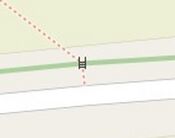Tag:barrier=stile
 |
| Description |
|---|
| A structure which provides people a passage through or over a boundary via steps, ladders or narrow gaps. |
| Rendering in OSM Carto |
| Group: barriers |
| Used on these elements |
| Status: approved |
| Tools for this tag |
|
A ![]() stile is a structure which allows people to pass through or over a linear
stile is a structure which allows people to pass through or over a linear barrier=* (i.e., a fence or wall) via steps, ladders or narrow gaps.
How to map
Add the tag barrier=stile to the node where the stile is located.
If there is a stile adjacent where a footpath and a road join, do not place the stile at the junction, but at a node on the footpath:
Stile types
Stepover stile
| Image | Notes | Tags |
|---|---|---|

|
Stone stepover stile | |

|
Stiles where people have to step over the barrier | |

|
Stepover stile in the Philippines (CAR) made out of bamboo, the crossbars on the right side in combination with the lowered portion of the fence is the way to cross the barrier | |
| See gettyimages or Pinterest post | Similar to a stepover stile where a number of horizontal beams need to be pressed down on one side. The other side is weighted, so that it closes by itself. Contrary to the regular stepover stile, it requires mechanical action to cross. (There are very few surviving.) |
Squeeze stile
Squeeze stiles are narrow passages in a fence or wall. They are sometimes V- or Y-shaped and may additionally have a step.
| Image | Notes | Tags |
|---|---|---|
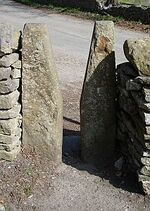
|
||

|
Wooden squeezer stiles often come with one step | |
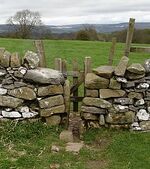
|
Difficulties in identifying the stile may occur where there is also a gate. Here there is a stone squeezer type stile. The landowner has more recently added a wooden gate. This is generally done because the barrier needs to retain smaller animals. |
barrier=stilestile=squeezermaterial=stone
|
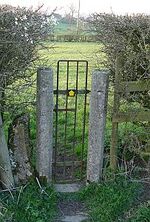
|
The above should not be confused with the following example: The above is a small gate, and should be tagged barrier=gate. The metal gate is not a recent addition and is part of the original barrier. The material for the posts is also concrete rather than stone.
|
barrier=gateAnd additional tags as per that page. |
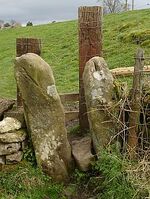
|
The primary historic interest will be the stone squeezer. | |
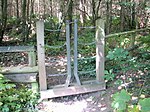
|
Ramblers' gate
Similar to a squeezer stile, but with movable parts. Sometimes referred to/ mapped as |
stile=ramblers_gate
|
Ladder stile
| Image | Notes | Tags |
|---|---|---|

|
||

|
Stiles where there is a ladder either side of the barrier. |
If known, the material should also be tagged. For example, stone stiles form part of the historic landscape character of the UK, and identifying their location is useful in preservation work. Where possible, the stile should be tagged with material=* with values stone, wood, or metal.
Tagging stile type is useful for evaluating how easy a stile is to use for people with restricted mobility, for example older people who want to hike but would have problem with ladders.
Step-over and ladder stiles can have the number of steps added using step_count=*, also useful to judge how demanding it will be to pass for people with limited mobility. step_count=* should be set to the number of steps on one side. If step count is different on each side, the larger one should be used.
Dog gate
Some stiles have small "dog gates" attached to them. There is a small hole at ground-level closed off by a plank of wood that can be pulled up from the top of the wall/barrier to open up the gate and allow a dog to pass through. The term is used in British Standard BS5709:2018. Tag these with dog_gate=yes.
-
Same pictured in Austria, to the very right in the photo, no liftable device but low opening, suitable for dogs but not cattle
Double stiles
Two stiles close together occur in frequently in some locations and may make the mapping of adjacent features, particularly hedges and fences, awkward.
Situations where these occur include:
- Stile at either end of a footbridge over a stream or river. These are straightforward. Example 660752957
 660752957
660752957 - The landowner has added a fence in front of pre-existing hedge which has required an additional stile. Presumably the hedge is no longer stock proof. Again fairly straightforward as both the original hedge and the fence can be mapped. Example 399074841
 399074841
399074841 - Very thick hedgerows (~ 5 m or more). Very often these appear to be two adjacent hedges which have merged. Often there is a stream or ditch as there is often a small footbridge between the stiles. Examples: 399074867
 399074867, 369403087
399074867, 369403087 369403087. The difficulty here is how to represent the hedge. Hedges are usually linear features, and Carto-OSM treats closed ways as linear features even when tagged with
369403087. The difficulty here is how to represent the hedge. Hedges are usually linear features, and Carto-OSM treats closed ways as linear features even when tagged with area=yes(partly because oftenbarrier=hedgeis often added to other features breaking the one feature one element rule.
See also
Other names
Norwegian: Gjerdeklyver, trapp
Common/possible tagging mistakes
- ↑ note that some people would tag 3 or 5 here - see https://github.com/streetcomplete/StreetComplete/pull/3932#discussion_r841193385
